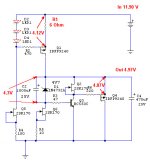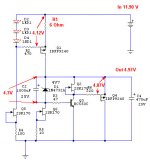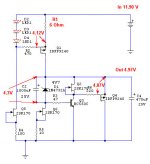Re: 5V Salas's Shunt Reg in B32S
You may want to make sure it's actually regulating. Regarding the 2sc1627a, is it an O or a Y? Both varieties are a bit low on hfe, it would make a bit of a difference for the loop gain. Dull, thin, lack of dynamic is exactly what this regulator is not about. IMHO the regulator is not working right. You may want to simplify things and make sure it works out of the whole setup right, i.e. make sure that the right shunt current goes through the shunt mosfet, that the 2sc1627a gets biased correctly (current through the reference?). You can use a simple reference such as three 1.7V or 1.8V yellow/green LEDs to test things out, and a resistor for load. Add a small resistor on the drain of the shunt mosfet and measure the voltage drop over it, then calculate the shunt current. Perhaps you've done all this, then never mind.
prakit said:I installed the reg in the dac last night and left it on for burn-in. This morning I checked it and everything was in order before gave it a listen.
To answer Woodenhead about the Vreg=5.6V, yes, it's slightly high but I think it's absolutely fine. If you use the 4,7V Zener for D1, it should be closer to optimal 5V.
This listening impression is relative to the Jung/Didden reg.
Good news first. Overall the dac sounds more liquid. The mid is slightly sweeter and more fleshed out. However, the good news stops here. It sounds very dull in the hi. The bass(in which I feel is the strength of B32S) is also a bit thin and not very tight. Sorry but I have to say it doesn't sound right.
I have a feeling that some parts are not working at their optimal point. 5V is quite low. Beside the D1 that I substitute with 2xLM336-2.5, I wonder if the choice for Q3 is critical? I can't find a BC550C so I liberally use a 2SC1627A here. All JFet were chosen according to specified Idss.
Best
Prakit
You may want to make sure it's actually regulating. Regarding the 2sc1627a, is it an O or a Y? Both varieties are a bit low on hfe, it would make a bit of a difference for the loop gain. Dull, thin, lack of dynamic is exactly what this regulator is not about. IMHO the regulator is not working right. You may want to simplify things and make sure it works out of the whole setup right, i.e. make sure that the right shunt current goes through the shunt mosfet, that the 2sc1627a gets biased correctly (current through the reference?). You can use a simple reference such as three 1.7V or 1.8V yellow/green LEDs to test things out, and a resistor for load. Add a small resistor on the drain of the shunt mosfet and measure the voltage drop over it, then calculate the shunt current. Perhaps you've done all this, then never mind.
Thanks for all the advices.
I agree that somethings in my reg are not working properly. 5V doesn't leave much margin for everything so it could be very tricky to get it to work properly. Will take sometime to sort things out to find the culprit. I'll report back how it goes.
Btw, the JD's series reg is very fine but it makes things sound a bit too crisp and too sharp for my taste. I know a shunt reg can do better.
Best
Prakit
I agree that somethings in my reg are not working properly. 5V doesn't leave much margin for everything so it could be very tricky to get it to work properly. Will take sometime to sort things out to find the culprit. I'll report back how it goes.
Btw, the JD's series reg is very fine but it makes things sound a bit too crisp and too sharp for my taste. I know a shunt reg can do better.
Best
Prakit
I am using 2 x LED + 1N4148 in series for 5V output. Less noise than Zener.
Shunting 225 mA, voltage output is 4.97V. Input is 12V. No oscillations so far.
shematic post #745.
@salas
Vgs for IRFP9240 is 4V. We are very close to margin with voltage reference at 4.3V and output at 5V.
Do you have any experience with MOSFETs with low gate treshold voltage?
Shunting 225 mA, voltage output is 4.97V. Input is 12V. No oscillations so far.
shematic post #745.
@salas
Vgs for IRFP9240 is 4V. We are very close to margin with voltage reference at 4.3V and output at 5V.
Do you have any experience with MOSFETs with low gate treshold voltage?
The Vref is sitting on Vbe so it is 4.97V actually. It will be no problem if there is low input ripple, lower than 1VP-P which is normally much lower than that. Did you actually measure the Vgs of Q1? It tends to go lower than 4V at low tensions. Looks like 3.15V to me if with 5.4V CCS LED string and R1=10R, ICCS=0.225A. You applied it to a DAC already? If yes, sounds OK?
stormsonic said:D1 as voltage reference 4.3V in my mind
Measured Vgs of Q1 = 5.3V
Weird number, are you sure that you did not measure Vds instead? Vgs is between pins 1 & 3.
stormsonic said:oops, correct drawing
No. Please measure between R2 at the Mosfet and under R1 at the Mosfet for Q1. Also measure across R1 only. Let us know.
Woodenhead said:
Hey Prakit, thanks for testing the circuit out for me! Do you think that 5.6V might be a little high for the Buffalo? How would the value be brought down a little?
Subjective thoughts on the differences between this and your previous regulator would be very interesting, as Salas says.
5.6V is actually rather low for the Buffalo. The supply feeds an LM4562 opamp that acts as a regulator, and it'll perform better with more volts across it. You should be looking at around 7V or more.
Spartacus said:
5.6V is actually rather low for the Buffalo. The supply feeds an LM4562 opamp that acts as a regulator, and it'll perform better with more volts across it. You should be looking at around 7V or more.
Perhaps even bypass the other regulator? Can you point to a schematic?
Salas said:
No. Please measure between R2 at the Mosfet and under R1 at the Mosfet for Q1. Also measure across R1 only. Let us know.
Values are correct, arrow is again pointing at wrong place
 Hope that drawing is now correct
Hope that drawing is now correct Voltage accros R1 is 1.365V. Value is 6.1 Ohm.
1.365V / 6.1 Ohm = 0.22377 A or 223.77 mA
Some thermal drifting, after 10 minutes voltage across R1 is 1.395, resulting in 228.68 mA.
Output is rock solid, always at 4.97V.
Attachments
Spartacus said:5.6V is actually rather low for the Buffalo. The supply feeds an LM4562 opamp that acts as a regulator, and it'll perform better with more volts across it. You should be looking at around 7V or more.
That is fortunate about explaining the indifferent and dull sound he gets. He must use a 7.2V Vref made out of 4 1.8V LEDs because 6-9V is the bad noisy region for Zeners, and listen again. At least 15V reg input. Q3 will work under a much better margin also.
stormsonic said:
Values are correct, arrow is again pointing at wrong placeHope that drawing is now correct

Voltage accros R1 is 1.365V. Value is 6.1 Ohm.
1.365V / 6.1 Ohm = 0.22377 A or 223.77 mA
Some thermal drifting, after 10 minutes voltage across R1 is 1.395, resulting in 228.68 mA.
Output is rock solid, always at 4.97V.
All that shows that the circuit is correctly working. What you want it for? Buffalo 32s again?
- Status
- This old topic is closed. If you want to reopen this topic, contact a moderator using the "Report Post" button.
- Home
- Amplifiers
- Power Supplies
- The simplistic Salas low voltage shunt regulator



